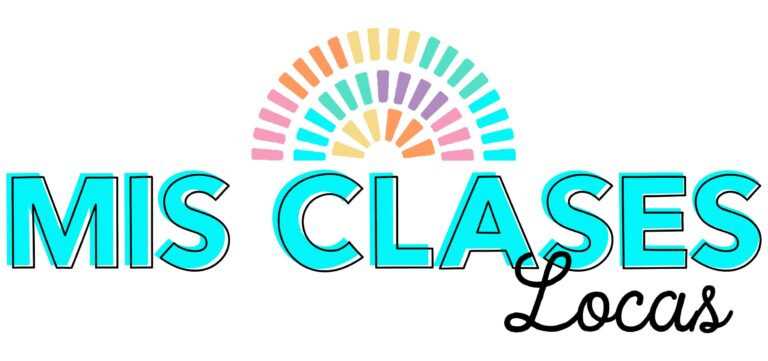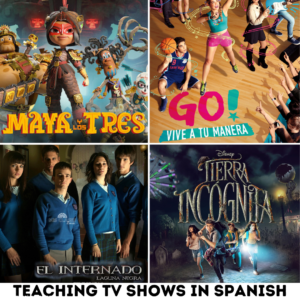90%+ Target Language
This is the goal we all (should) strive for. Was my class 90% in Spanish my first year teaching when I was using the traditional textbook, grammar, vocab, workbook, and chapter test approach? Absolutely not. Am I getting better since moving to more of a CI approach? Yes. Am I perfect? No. As I heard mam Dugger say last night “practice makes progress.”
Using Movies with Comprehensible Input
Update: Here are films & resources I would use for movies in Spanish Class.
I have learned that the student output in class is directly related to the input and activities that I provide. While doing Martina Bex’s awesome Muertos Unit chock full of CI resources, I am providing the input and students are amazing me with their output, even in Spanish 1. This class also just finished Martina’s Siéntate unit, and I was SO IMPRESSED with the participation IN SPANISH. I am been slowly sipping on the CI Kool Aid for a while now but now I am chugging and can not get enough.
Which Way Home in Spanish Class
So in the midst of my CI transformation, we were finishing up our Spanish III unit on immigration, focusing on the novel Esperanza by Carol Gaab, with the movie Which Way Home. It was my first time showing the movie in class, so I bought a great movie guide to accompany it. With the mindset of 90% Target Language on day one of the movie I clicked “movie in Spanish.” Day one bombed. Bad.
Issue #1
- There were no Spanish subtitles available. This class is used to watching authentic shows in Spanish since they watch El Internado every Friday. But, with El Internado, I use the Spanish subtitles along with the Spanish audio, which is a LIFESAVER for visual learners who are having a hard time with speed or accent.
90%+ Target Language
This is the goal we all (should) strive for. Was my class 90% in Spanish my first year teaching when I was using the traditional textbook, grammar, vocab, workbook, and chapter test approach? Absolutely not. Am I getting better since moving to more of a CI approach? Yes. Am I perfect? No. As I heard mam Dugger say last night “practice makes progress.”
Using Movies with Comprehensible Input
Update: Here are films & resources I would use for movies in Spanish Class.
I have learned that the student output in class is directly related to the input and activities that I provide. While doing Martina Bex’s awesome Muertos Unit chock full of CI resources, I am providing the input and students are amazing me with their output, even in Spanish 1. This class also just finished Martina’s Siéntate unit, and I was SO IMPRESSED with the participation IN SPANISH. I am been slowly sipping on the CI Kool Aid for a while now but now I am chugging and can not get enough.
Which Way Home in Spanish Class
So in the midst of my CI transformation, we were finishing up our Spanish III unit on immigration, focusing on the novel Esperanza by Carol Gaab, with the movie Which Way Home. It was my first time showing the movie in class, so I bought a great movie guide to accompany it. With the mindset of 90% Target Language on day one of the movie I clicked “movie in Spanish.” Day one bombed. Bad.
Issue #1
- There were no Spanish subtitles available. This class is used to watching authentic shows in Spanish since they watch El Internado every Friday. But, with El Internado, I use the Spanish subtitles along with the Spanish audio, which is a LIFESAVER for visual learners who are having a hard time with speed or accent.
Problem #2
- I did not comprehensify the movie enough. I should have been pausing more frequently to repeat, checking for understanding, and making sure that the students were comprehending the heavy accents of the children’s slang, and mumbled speech over the sound of the train they are riding on top of. I was on a self-imposed timeline of finishing the movie within a certain amount of days and did not allow enough time for pausing and discussion.
Issue #3
- I was too proud. When I saw the obvious signs of frustration, (students getting agitated, complaining they did not get it, checking out completely) I should have changed the course of class midway. I was too proud. I felt that by turning on the English subtitles I was giving in to their request, letting them “win,” and most of all failing as a teacher. To me, having English subtitles gave them permission to not listen in Spanish, but instead just read. It meant that I had not prepared them well enough, that I had not taught them like I should have. But I was wrong

Reflecting on Subtitles in Spanish Class
While reflecting that night, I came to the question “What is the goal of watching this movie?” Was the goal for the students to understand the varied and difficult speech of children from Central America? No, the goal was to reflect on immigration and begin to understand the journey of unaccompanied migrant children. I realized that the CONTENT of the movie was too important to have them bogged down by the language.
This movie has the possibility of contributing to a “life changing lesson,” forever changing a small town young adult’s view on immigration forever. Adding a safety net of English subtitles may help the students reach this goal, and ultimately see the current child refuge crisis in the US in a different light.

Turning on the English Subtitles
So, on day 2 I apologized for not supporting them enough on day 1, turned on the English subtitles, and tried to help to make the movie more comprehensible for the students. And you know what? We made it to our end goal. While discussing the movie, I had students share some REALLY great reflections of how the movie made them FEEL. I was told their views on immigration had changed, that they felt horrible for immigrant children, and that they now understand why these unaccompanied children are now being called refugees.
90%+ Target Language. That is the goal for each class. But, the end goal as a language educator is also to help prepare the whole student to be a citizen of the world, and I have learned this means sometimes you need to turn on the English subtitles.
Here’s to learning and growing everyday. – Allison





